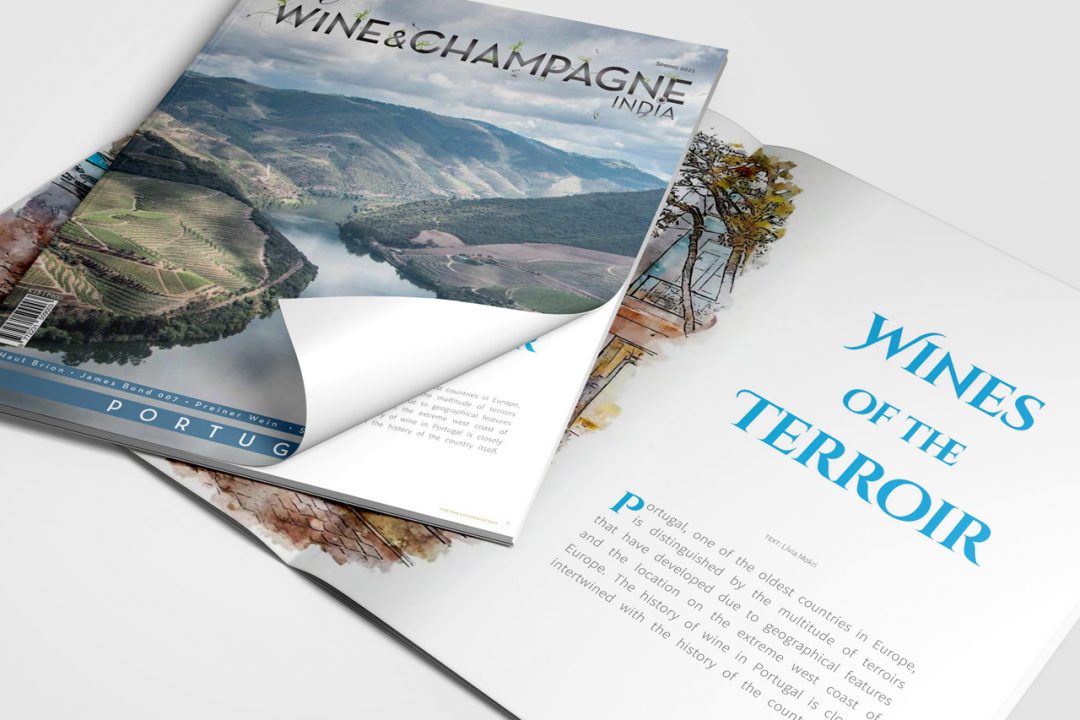Portugal, one of the oldest countries in Europe, is distinguished by the multitude of terroirs that have developed due to geographical features and the location on the extreme west coast of Europe. The history of wine in Portugal is closely intertwined with the history of the country itself.
HISTORY
Every ruler has had a significant impact on viticultural practices. The Iberian tribes, who arrived on the peninsula around 2000 BC, started viticultural activities in the Tagus and Sado valleys. The Celts imported grape varieties and improved viticultural techniques. Colonies like Portugal, which were in Roman occupation since 216 BC, were tasked to satisfy demand and ensure that wine flowed abundantly throughout the Roman Empire. In the 5th century, the Visigoths made it mandatory to use real wine from grapes at mass. The Moorish conquest early in the 8th century brought an Arab influence on the Iberian viticulture. In the 12th century, during the reign of King Alfonz I, wine became an export product – Portuguese wines gained popularity in other parts of Europe. When the first ships of discovery set sail, and Portuguese supremacy was extended in the East, control of the “Spice Route” was seized. The wine was traded as Portugal became a maritime power. In 1580, King Philip II of Spain claimed the throne and under Spanish rule, Lisbon became the center of the empire’s wine consumption and distribution. Portuguese wine sailed to every corner of the world.
BIRTH OF PORT
With England at war with France in the 17th and 18th centuries, it turned to its old ally, Portugal, for its supplies of wine. The distance of the main vineyards in the Douro from the ports made wines suffer temperature fluctuation and movement, often degrading their quality. In order for the wine to survive this journey across the channel, Portuguese winemakers strengthened the wine with a little brandy. This halted the fermentation, made the wine sweeter, more robust, with higher alcohol content. This wine suited much better the English taste and was a huge success in England. Soon, the technique of fortification with brandy was deliberately used – creating Port wine. And the rest is already history!
DIVERSE REGIONS
Although a relatively small country, Portugal enjoys enormous geographical and climatic variety. In the north and east, the Continental influences lead to large temperature fluctuations, cold winters and warm summers with little rainfall. In the west, fresh and wet winds from the Atlantic bring high rainfall. In the south, the Mediterranean influence results in hot, dry summers and mild winters. Soil types are also very different. In the north, it’s granite and slate. In the central regions, it’s clay and limestone. And in the south, it’s clay and sand.
Portugal has the highest density of “Autochthonous” grapes varieties in Europe. More than 250 grape varieties are indigenous to Portugal, so well adapted to the terroir and so unique that they have no mutations anywhere else. The most well-known being Touriga Franca, Tinta Roriz, Touriga Nacional, Trincadeira, Baga and Castelão in the reds and Alvarinho, Arinto, Fernão Pires and Encruzado in the whites. The international varietals – Chardonnay, Sauvignon Blanc, Cabernet Sauvignon, Merlot, Pinot Noir and Syrah – have also been recently added to the mix.
This abundance of grape varieties combined with various micro[1]climates contribute to diversity. Growers are open to new ideas and experiments. Using centuries of experience, they invest heavily in getting the maximum from each varietal that they grow. The winemakers are master blenders and extremely innovative. All of this means that Portugal is capable of producing an exciting range of unique wines – with styles ranging from traditional sweeter styles to full-bodied reds to crisp acidic whites
WINE REGIONS
Currently, 14 wine regions are classified as DOC (Denominação de Origem Controlada meaning Controlled Designation of Origin) and they cover more than half a million hectares of vineyards across Portugal.
The Douro is by far the most significant and well-known. This is the oldest demarcated wine region in the world, since 1756 (although the jury is still out over the Tokaj-Hegyalja region’s claim). The region covers some 250,000 hectares, but only 15% are planted with vines and only 26,000 hectares are authorized for Port wine production. Despite its primary association with Port wine, the Douro produces just as much non-fortified table wine (typically referred to as “Douro wines”) as it does fortified wine.
The largest wine region is Vinho Verde. Historically, these wines were the first Portuguese wines to be exported to other European markets in the 16th and 17th centuries. In this geographically well-located region, the Atlantic Ocean influences a mild climate, which, together with the mostly granite soil and heavy rains, is reflected in the freshness, lightness and elegance of the wines. A large part of the region’s wines is white, to be consumed at a young age.
Another prominent wine region, located just south of the Douro Valley, is Dão – the birthplace of the Touriga Nacional and Encruzado grape varieties. Sheltered on three sides by granite mountain ranges, among them the famous Serra da Estrela, the region is on a plateau that protects its temperate climate from the effects of the Atlantic that is not that far away. This is the perfect terrain for making fine, elegant, fruity wines with good acidity.
Next to the Dão, the Beira Interior region has been producing wine for centuries on its around 16,000 hectares of vineyards. The wines of this region are influenced by the extreme continental climate and the mostly granitic soil, resulting in fresh and aromatic white wines and also fresh red wines with aromas of red fruits and spices.
Wine-lovers rate Alentejo, one of the largest wine regions, as the top wine region in Portugal. An excellent terroir makes wines that are among the best Portuguese wines that receive many international recognitions. Although it stretches over almost a third of mainland Portugal, only five percent of its land is planted with vines. Hot and dry, with a Mediterranean climate and many types of soils (shale, clay, marble, granite and limestone), the largest wine region is best known for its reds from Aragonez, Castelão or Trincadeira, which are full-bodied and rich in tannins with aromas of wild berries. The whites are generally mild, slightly acidic, with aromas of tropical fruits.
Trás-os-Montes (Beyond the Mountains), north of the Douro, is a mountainous area with rather poor granite or schist soils. The high altitude vineyards bear the typical Continental climate – long and hot summers, and long and cold winters. The reds are fruity and full-bodied, while the whites are smooth with floral aromas.
Tejo (previously known as Ribatejo) is in the heart of Portugal, a short distance from the capital is a tribute to the river that has defined its landscape, climate and economy for centuries. The main waterway connection between Madrid and Lisbon, Ribatejo has always been a rich and affluent region. The main grape varieties here are the noble Touriga Nacional as well as the Trincadeira, Castelão, Aragonês, the aromatic Fernão Pires and the lively Arinto.
Península de Setúbal, to the south of Lisbon, covers an area of about 9,500 hectares of vineyards. The symbiosis between the Mediterranean climate and the two soil types (clay-limestone and sand) in the area creates perfect conditions for high-quality grapes. The best-known wine, the dessert wine Moscatel de Setúbal, is a fortified white wine made from Moscatel grapes and aged for many years in oak barrels.
Algarve enjoys the southernmost location in the country. The Monchique mountains protect it from the cold north winds, and its southern-facing aspect creates a favorable Mediterranean climate for vines. The same bright sunshine, warm air and sea breeze which brings tourists to Portugal’s top holiday destination, in their droves, are precisely what grapes require to give prolific yields and fruit with sky-high potential alcohol. The region’s red wines are soft, low in acidity, and high in alcohol, and the straw-colored whites are full-bodied, best enjoyed chilled.
In the middle of the Atlantic Ocean, halfway between Europe and North America, is the Portuguese archipelago Azores. Only three Azorean islands (Pico, Terceira and Graciosa) could continue the winemaking tradition after the phylloxera in 1857. Nowadays, most of the region’s wines come from the second-largest island Pico, the Island of Wine, named after a beautiful and sometimes snow-capped volcanic peak that dominates the landscape. The vineyards are in extreme conditions, very close to the sea, in volcanic soil and surrounded by spectacular, reticulated stone walls made of black basalt stones. Most wines are white, and, thanks to the damp, temperate climate and the oceanic winds, they are fresh and salty.
Madeira, the Pearl of the Atlantic, is an island in the Atlantic Ocean. The temperate, humid climate and fertile volcanic soil give gently ripened grapes and light wines with moderate alcohol. Typically, a mono-varietal fortified white wine, aged under heat, marked by high acidity levels, Madeira is made from specific grapes vinified to different degrees of sweetness: Sercial (dry), Verdelho (semi-dry), Bual (semi-sweet), and Malvasia (sweet).
Lisbon is one of the few capitals in the world with a wine region in its name. The region of Lisboa (formerly known as Estremadura) is one of the most productive regions in Portugal with a temperate climate. Its regional wines, from saying Alenquer and Bucelas, are well known for their good quality to price ratio.
Portugal boasts that two of its wine regions are recognized as UNESCO World Heritage Sites: the Douro Valley and the wine region of Pico on the Azores.
NEW STYLES
The sparkling style is gaining a growing reputation. Távora[1]Varosa was the first wine region to be demarcated for the production of sparkling wines in 1989. The climate is continental, so winters are cold and humid, summers are hot and dry. The vines grow at an average altitude of 500 to 800 meters above sea level, on granite and low-water-retaining slate soils. The grapes maintain good acidity and fruitiness.
Nevertheless, most of the Portuguese sparkling (around 80%) comes from the Bairrada region, where the high acidity that is required is perfectly provided by the cool climate. Sparkling wines are mostly made in the traditional method, so the second fermentation takes place in the bottle. Long-lasting, dry, quality sparklings are born – both white and red. The high-quality Blanc de Noirs made from Baga grapes, the main red varietal in Bairrada, are exceptional.
WINE MAKING MAESTROS
Portuguese winemakers combine the rich heritage of traditional methods that they have inherited with state-of-the-art technology to make wines that are as unique as possible. The sheer selection in their hands allows them to create countless different profiles for their wines, wherever they are in the country. They strive to discover special experiences and flavors by blending different components, almost on an artistic level.
BIG STEPS
The difficulties of the 19th century, marked a dark period for viticulture, as first the powdery mildew and then the phylloxera epidemic devastated the wine regions – except Colares and the Algarve which had sandy soils. At the beginning of the 20th century, Portuguese institutions like Estado Novo (in 1926) and National Wine Council (in 1937), were set up to regulate wine.
For years, Portugal had been reputed for its Port wines, but increased investments, development of viticultural techniques, and modernization have yielded exciting results for other wine styles from across the country. Since the nineties, Portugal has been a leader in wine production and export, to which their accession to the European Economic Community in 1986 also contributed greatly. Currently, Portugal is the 9th largest wine exporter in the world and the 11th largest wine-producing country in the world.
Portugal offers more opportunities for discovery than we could ever imagine, given the huge diversity and uniqueness of the wines that come from its wine regions. Little wonder that the Portuguese have always been the biggest consumers of their own fantastic wines, and there is only so much that they can ship to connoisseurs around the world.
Published in FINE Wine & Champagne India magazine, Spring 2021



No Comments Found